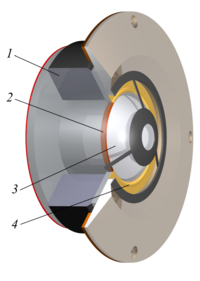
Photo from wikipedia
Earthquake-induced pulse-like ground motions are often observed in near-source conditions due to forward-directivity. Recent worldwide earthquakes have emphasised the severe damage potential of such pulse-like ground motions. This paper introduces… Click to show full abstract
Earthquake-induced pulse-like ground motions are often observed in near-source conditions due to forward-directivity. Recent worldwide earthquakes have emphasised the severe damage potential of such pulse-like ground motions. This paper introduces a framework to quantify the impact of directivity-induced pulse-like ground motions on the direct economic losses of building portfolios. To this aim, a simulation-based probabilistic risk modelling framework is implemented for various synthetic building portfolios located either in the fault-parallel or fault-normal orientations with respect to a case-study strike–slip fault. Three low-to-mid-rise building typologies representative of distinct vulnerability classes in the Mediterranean region are considered: non-ductile moment-resisting reinforced concrete (RC) frames with masonry infills, mainly designed to only sustain gravity loads (i.e. pre-code frames); moment-resisting RC infilled frames designed considering seismic provisions for high ductility capacity (i.e. special-code frames); special-code steel moment-resisting frames. Monte Carlo-based probabilistic seismic hazard analysis is first performed, considering the relevant modifications to account for the pulse-occurrence probability and the resulting spectral amplification. Hazard curves for sites/buildings located at different distances from the fault are obtained, discussing the spatial distribution of the hazard amplification. A set of pulse-like ground motions and a set of one-to-one spectrally-equivalent ordinary records are used to perform non-linear dynamic analysis and derive fragility relationships for each considered building typology. A vulnerability model is finally built by combining the derived fragility relationships with a (building-level) damage-to-loss model. The results are presented in terms of intensity-based and expected annual loss for synthetic portfolios of different sizes and distribution of building types. It is shown that, for particularly short-period structures (e.g. infilled RC frames), the influence of near-source directivity can be reasonably neglected in the fragility derivation while kept in place in the hazard component. Overall, near-source directivity effects are significant when estimating losses of individual buildings or small portfolios located very close to a fault. Nevertheless, the impact of pulse-like ground motions on losses for larger portfolios can be considered minimal and can be neglected in most of the practical large-scale seismic risk assessment applications.
Journal Title: Bulletin of Earthquake Engineering
Year Published: 2020
Link to full text (if available)
Share on Social Media: Sign Up to like & get
recommendations!